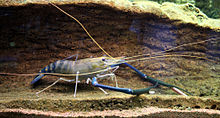Draft:Giant freshwater shrimp
| Submission declined on 28 February 2024 by KylieTastic (talk). Thank you for your submission, but the subject of this article already exists in Wikipedia. You can find it and improve it at Macrobrachium rosenbergii instead.
Where to get help
How to improve a draft
You can also browse Wikipedia:Featured articles and Wikipedia:Good articles to find examples of Wikipedia's best writing on topics similar to your proposed article. Improving your odds of a speedy review To improve your odds of a faster review, tag your draft with relevant WikiProject tags using the button below. This will let reviewers know a new draft has been submitted in their area of interest. For instance, if you wrote about a female astronomer, you would want to add the Biography, Astronomy, and Women scientists tags. Editor resources
|  |
| Giant freshwater shrimp | |
|---|---|

| |
| Giant freshwater shrimp | |
| Scientific classification | |
| Domain: | Eukaryota
|
| Kingdom: | Animalia
|
| Phylum: | Arthropoda
|
| Class: | Malacostraca
|
| Order: | Decapoda
|
| Suborder: | Pleocyemata
|
| Infraorder: | Caridea
|
| Family: | Palaemonidae
|
| Genus: | Macrobrachium
|
| Species: | M. rosenbergii
|
| Binomial name | |
| Macrobrachium rosenbergii | |
The giant freshwater shrimp (Macrobrachium rosenbergii) is an invertebrate species raised in aquaculture and captured through fishing around the world. A female giant freshwater prawn lays about 10,000-50,000 eggs; she does so five times each year. This species originates in parts of the Indian and Pacific Oceans around Asia and is among the largest freshwater prawns in the world. Although it is a freshwater shrimp, it needs seawater to develop from the larval stage, and once it has become a small shrimp, this species lives only in fresh water. This species is identified by its claws, which are often more than twice the size of the shrimp's body. When the shrimp is developing from a small shrimp to a full-grown shrimp, it changes from orange to blue.

Markets and physical characteristics[edit]
Prawns are generally stable in demand in many parts of the world when it comes to cooking at home, in restaurants and are often categorized as a quality food. The giant freshwater prawn is used in the culinary world due to its size. The average size is about 30 cm in length and can be up to 45 cm or longer in some cases. Usually, a fully grown king prawn is around 500 gr. which is a lot for shrimp. The body consists of 6 joints, on top of the third tail joint is a small spine. When the shrimp is on the bottom, it walks on its hind legs, but when it swims, it flaps its tail and shoots backwards. Female shrimp can be distinguished as they have a larger stomach, shorter hind legs and are usually smaller than the male shrimp.
There are three different types of males. The first level is called "small male" (symbolized by: SM); in this youngest stage it has short, almost transparent claws. If everything goes as it should, the little guy grows and gets orange claws (known as: OC), which can be 0.8 to 1.4 times their body length. OC males then transform into the third and final stage where they are given blue claws (denoted by: BC). When they get blue claws, they can grow to twice their body length.
Propagation and cultivation[edit]
The giant freshwater prawn is found wild in many parts of India, Southeast Asia and northern Australia. After the demand for this breed increased, it has been introduced to other regions such as Africa, Thailand, China, Japan, America, etc. It has helped a lot with the development of its cultivation in fire. Its cultivation has become widespread and has made a significant contribution to the aquaculture industry. The adaptability of this shrimp species to diverse environments and its rapid growth make it a lucrative option for aquaculturists. The global demand for giant shrimp in the food industry further increases its economic importance.
As you can see in the picture below, there are some key points when it comes to breeding. First, stock must be obtained from ponds or by fishing, maintaining a balanced sex ratio to maximize external fertilization. When external fertilization has been successful, the female shrimp lays the eggs on the outside and they are carefully removed from the shrimp and placed in prepared tanks where a metamorphosis in 11 steps takes place and takes 16-35 days. After that process, the shrimp are put into tanks that are specially fed to keep the fry safe and with enough food to grow as fast as possible. After that process, they go to bigger ponds to grow even more. From there they are caught and sold fresh, on ice or completely frozen at -20°C.
References[edit]
del Mundo, C. M.Computer generated species distribution map. https://www.aquamaps.org/receive.php?type_of_map=regular&map=cached
FAO. (2021). Fishery and Aquaculture Statistics. [Global capture production 1950-2019] (FishStatJ). http://www.fao.org/fishery/statistics/software/FishStatJ/en
FAO.(2009) - macrobrachium rosenbergii.
https://www.fao.org/fishery/docs/CDrom/aquaculture/I1129m/file/en/en_giantriverprawn.htm
Proceedings of the world scientific conference on the biology and culture of shrimps and prawns/actes de la conference scientifique mondiale sur la biologie et l'elevage des crevettes/actas de la conferencia cientifica mundial sobre biologia y cultivo de camarones y gambas.
https://www.fao.org/3/AC741T/AC741T01.htm
S.W. LING.Proceedings of the world scientific conference on the biology and culture of shrimps and prawns/actes de la conference scientifique mondiale sur la biologie et l'elevage des crevettes/actas de la conferencia cientifica mundial sobre biologia y cultivo de camarones y gambas.
https://www.fao.org/3/AC741T/AC741T01.htm
Thumbnails summary.
https://www.sealifebase.ca/photos/ThumbnailsSummary.php?Genus=Macrobrachium&Species=rosenbergii
Wikipedia. (2024). Macrobrachium rosenbergii. https://en.wikipedia.org/w/index.php?title=Macrobrachium_rosenbergii&oldid=1209023380
- ^ De Grave, S.; Shy, J.; Wowor, D.; Page, T. (2013). "Macrobrachium rosenbergii". IUCN Red List of Threatened Species. 2013: e.T197873A2503520. doi:10.2305/IUCN.UK.2013-1.RLTS.T197873A2503520.en. Retrieved 19 November 2021.

